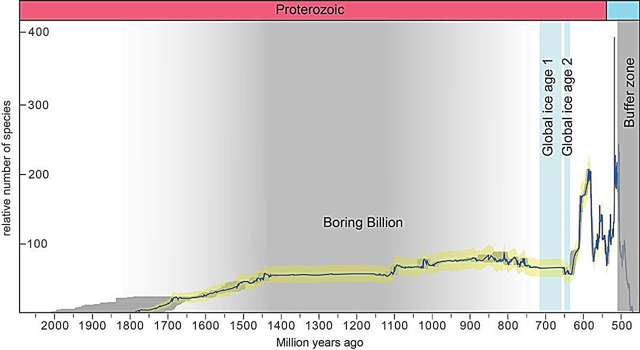Global ice ages accelerated the evolution of life on Earth.
Eukaryotes, or organisms with a nucleus in their cells, include fungi, plants, and animals (as well as groups of organisms known as "protists"). Despite their differences, they are believed to share a common origin: according to the most widely accepted hypotheses, eukaryotes emerged between 1.6 and 2.1 billion years ago.
To understand how climate change, fluctuations in ocean oxygen levels, and other geochemical processes have influenced the evolution of these organisms, an international team of scientists from the Chinese Academy of Sciences, Virginia Tech (USA), Nanjing University (China), and the Russian Academy of Sciences collected and analyzed data on the presence of ancient marine eukaryotes from the beginning of the Proterozoic (about 2.5 billion years ago) to the start of the Cambrian period (around 539 million years ago) in geological layers around the world.
The researchers, led by Qing Tang and Shuhai Xiao, correlated the intervals of species emergence and extinction, taking into account radiometric dating data using a program called Constrained Optimization (CONOP). This approach enabled them to construct a detailed and accurate timeline of fluctuations in the number of eukaryotic species over time.
The results of the research, published in the journal Science, indicated that from 1.8 to 0.8 billion years ago, the abundance and diversity of eukaryotic life forms remained at a relatively stable, albeit low, level. This suggests that evolution was progressing very slowly, allowing species to exist for millions of years without significant changes.
Everything changed after two global Cryogenian glaciation events (approximately 720 to 635 million years ago): when all landmasses were completely covered with ice, the dynamics of ancient eukaryotic evolution noticeably accelerated. Moreover, both mass extinctions and bursts of speciation became more frequent (in the intervals between glaciations).

The authors of the new study concluded that species began to "replace" one another more frequently and actively around 635-539 million years ago, which set the stage for the subsequent Cambrian explosion—a mass emergence of new life forms.
The resulting "map of life" revealed that after an extended period of "stagnation," sharp climatic changes, particularly intense glaciations, contributed to the acceleration of evolutionary processes and the emergence of new groups of organisms. Thus, ancient species could evolve much more slowly and exist longer, but following global glaciations, the pace of evolution significantly increased.
The observed patterns of rises and falls in the history of ancient life on Earth raise numerous questions for future research: scientists will need to explain the prolonged "stability" prior to glaciations, the role of climatic catastrophes, fluctuations in ocean oxygen levels, as well as determine whether interspecies competition could have triggered an evolutionary "arms race."
The findings of the study will also help predict how contemporary ecosystems may cope with global climate changes and better understand the causes and mechanisms behind mass extinctions and major "jumps" in evolution.
"Our results provide the most comprehensive and detailed picture of Proterozoic eukaryotic diversity. We hope this research will serve as a starting point for future studies," the authors of the scientific work concluded.